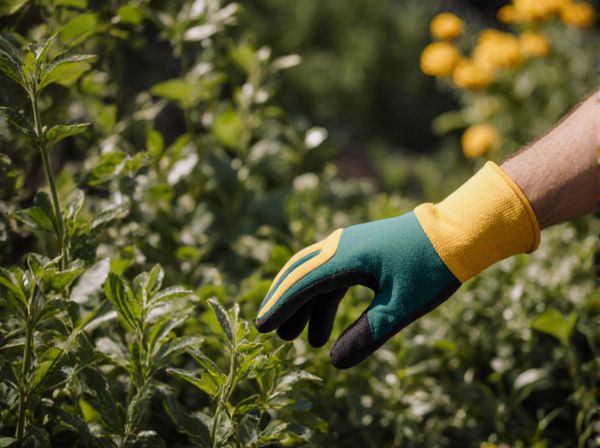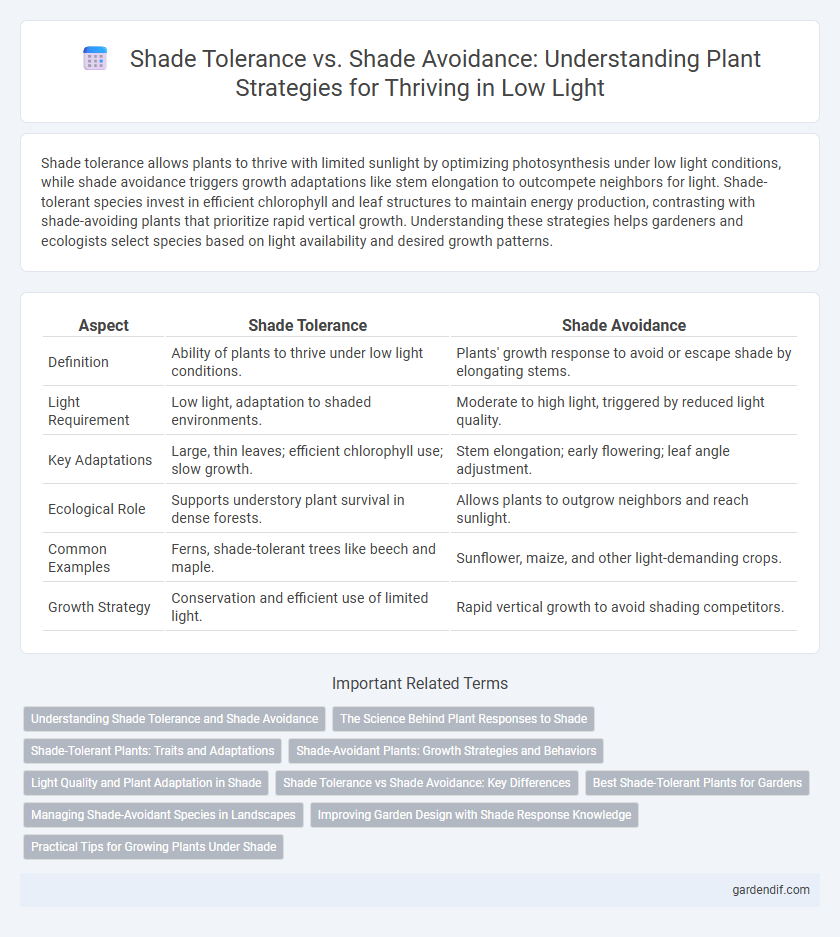
Shade Tolerance vs Shade Avoidance Illustration
Shade tolerance allows plants to thrive with limited sunlight by optimizing photosynthesis under low light conditions, while shade avoidance triggers growth adaptations like stem elongation to outcompete neighbors for light. Shade-tolerant species invest in efficient chlorophyll and leaf structures to maintain energy production, contrasting with shade-avoiding plants that prioritize rapid vertical growth. Understanding these strategies helps gardeners and ecologists select species based on light availability and desired growth patterns.
Table of Comparison
| Aspect | Shade Tolerance | Shade Avoidance |
|---|---|---|
| Definition | Ability of plants to thrive under low light conditions. | Plants' growth response to avoid or escape shade by elongating stems. |
| Light Requirement | Low light, adaptation to shaded environments. | Moderate to high light, triggered by reduced light quality. |
| Key Adaptations | Large, thin leaves; efficient chlorophyll use; slow growth. | Stem elongation; early flowering; leaf angle adjustment. |
| Ecological Role | Supports understory plant survival in dense forests. | Allows plants to outgrow neighbors and reach sunlight. |
| Common Examples | Ferns, shade-tolerant trees like beech and maple. | Sunflower, maize, and other light-demanding crops. |
| Growth Strategy | Conservation and efficient use of limited light. | Rapid vertical growth to avoid shading competitors. |
Understanding Shade Tolerance and Shade Avoidance
Shade tolerance refers to a plant's ability to thrive in low light conditions by efficient photosynthesis and altered leaf morphology, whereas shade avoidance involves rapid elongation and growth towards light sources to outcompete neighbors. Key species exhibiting shade tolerance include ferns and understory shrubs, which adapt by producing large, thin leaves with high chlorophyll content. In contrast, shade-avoidant plants like sunflowers prioritize stem elongation and delayed leaf development to escape shaded environments.
The Science Behind Plant Responses to Shade
Shade tolerance involves plants adapting physiologically and morphologically to low light conditions by optimizing chlorophyll content and leaf anatomy for efficient photosynthesis. Shade avoidance is triggered by changes in the red to far-red light ratio, activating phytochrome photoreceptors that induce stem elongation and leaf angle adjustments to outgrow competitors. These divergent responses are regulated by complex signaling pathways involving hormones such as auxins, gibberellins, and ethylene, enabling plants to balance survival and growth strategies under shaded environments.
Shade-Tolerant Plants: Traits and Adaptations
Shade-tolerant plants exhibit specific traits such as larger, thinner leaves with higher chlorophyll content to maximize light absorption in low-light environments. These plants often have slower growth rates and efficient photosynthetic mechanisms to survive under dense canopy cover. Adaptations include enhanced chloroplast movement, increased leaf surface area, and altered pigment composition to optimize light capture.
Shade-Avoidant Plants: Growth Strategies and Behaviors
Shade-avoidant plants exhibit rapid stem elongation and leaf expansion to outgrow competitors and reach sunlight in densely shaded environments. These species prioritize vertical growth over biomass allocation to roots, enabling them to escape low light conditions quickly. Adaptive behaviors include increased auxin production and enhanced photoreceptor sensitivity, which trigger morphological changes optimizing light capture.
Light Quality and Plant Adaptation in Shade
Shade tolerance in plants involves adaptation to low light quality, primarily characterized by reduced red to far-red light ratios, enabling efficient photosynthesis under canopy shade. Shade-avoiding plants detect changes in light quality through phytochrome photoreceptors, triggering elongation growth to outgrow competitors and reach better light conditions. These contrasting strategies highlight evolutionary adaptations in plant morphology and physiology to optimize survival and growth in shaded environments.
Shade Tolerance vs Shade Avoidance: Key Differences
Shade tolerance enables plants to thrive in low light by adapting their photosynthetic efficiency and leaf morphology, while shade avoidance triggers elongated growth and early flowering to outcompete neighbors for sunlight. Shade-tolerant species optimize chlorophyll content and leaf area to maximize light capture, whereas shade-avoiding species exhibit rapid stem elongation and reduced leaf expansion to escape shaded environments. Understanding these key differences helps in selecting appropriate vegetation for forestry, agriculture, and landscaping under varied light conditions.
Best Shade-Tolerant Plants for Gardens
Shade-tolerant plants such as hostas, ferns, and astilbes thrive in low-light garden environments by adapting to limited sunlight, unlike shade avoidance plants that grow taller to reach light. These species optimize photosynthesis under shaded conditions through broader leaves and slower growth rates, making them ideal for shaded garden areas. Selecting the best shade-tolerant plants enhances garden aesthetics and ensures healthy foliage where sunlight is scarce.
Managing Shade-Avoidant Species in Landscapes
Managing shade-avoidant species in landscapes requires strategic placement to ensure adequate sunlight exposure for optimal growth. Pruning overstory plants and selecting shade-tolerant companion species can mitigate competition for light and promote healthier development. Implementing these techniques enhances landscape resilience by balancing sunlight distribution and reducing stress on shade-avoidant vegetation.
Improving Garden Design with Shade Response Knowledge
Understanding shade tolerance and shade avoidance is crucial for improving garden design, as selecting plants with appropriate shade responses ensures optimal growth and aesthetic appeal. Shade-tolerant plants thrive under low light by modifying photosynthesis and morphology, while shade-avoidant species grow rapidly toward light sources, often increasing stem elongation. Incorporating these characteristics allows gardeners to strategically position plants for balanced light distribution, enhancing overall garden health and visual harmony.
Practical Tips for Growing Plants Under Shade
Shade tolerance enables plants like ferns and hostas to thrive with limited sunlight by efficiently utilizing low-light conditions, while shade avoidance triggers elongated growth in sun-loving plants to reach light sources. Practical tips for growing plants under shade include selecting species with high chlorophyll concentration and broad leaves to maximize light capture, and providing consistent moisture to support photosynthesis and prevent stress. Using mulch to regulate soil temperature and reduce evaporation further enhances growth in shaded environments by maintaining optimal root health.
Shade Tolerance vs Shade Avoidance Infographic

 gardendif.com
gardendif.com